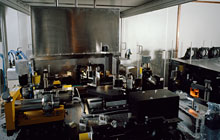MIDI
MID-infrared Interferometric instrument
MIDI, overseen by Instrument Scientist Thomas Rivinius and Instrument Fellow André Müller at Paranal Observatory, was at one point one of three interferometers installed for use with the Very Large Telescope Interferometer (VLTI), alongside AMBER and PIONIER.
"MIDI covered the mid-infrared wavelength range (8–13 micrometres) for the VLTI, making it ideal for observing relatively cool (around 30°C), dusty environments around young stars, evolved stars, and active galactic nuclei (AGN)," explains André. "This differs from AMBER, the other instrument on VLTI, which operates in the near-infrared to observe hot dust at a temperature of around 1200°C and molecules that have been directly exposed to the central star."
 MIDI, like other interferometers, didn’t produce an image as seen with other VLT instruments such as FORS2 or HAWK-I. Instead, it produced a series of interference fringes, the details of which can be found on the main interferometry page. By combining the incoming light from a combination of two Unit Telescopes (UTs) and Auxiliary Telescopes (ATs), the baseline of the observations— the distance between the two telescopes in use — can be changed to capture different pieces of data about an astronomical object.
MIDI, like other interferometers, didn’t produce an image as seen with other VLT instruments such as FORS2 or HAWK-I. Instead, it produced a series of interference fringes, the details of which can be found on the main interferometry page. By combining the incoming light from a combination of two Unit Telescopes (UTs) and Auxiliary Telescopes (ATs), the baseline of the observations— the distance between the two telescopes in use — can be changed to capture different pieces of data about an astronomical object.
As well as interferometry, MIDI also possessed some basic spectroscopic capabilities which could split the incoming light into its different colours, or wavelengths, just as a prism does. This capability was sufficient to pick out features that show the presence of silicates, which are the main ingredient of cosmic dust. MIDI could show us how and where they are produced in the disc surrounding a young star, which is an important factor for models of planet formation.
"The strength of the interferometric signal observed at various telescope separations and orientations, can be interpreted and modelled to give information about the physical dimensions and shape of an object, for instance whether it is symmetrical or asymmetrical, and its chemical composition in relation to its distance from the target star," André concludes.
In other words, MIDI did not produce super-sharp images — in fact, it did not produce images at all! But each measurement obtained with one pair of telescopes gave one piece of information on how large the astronomical object appears at a given wavelength and in a given direction. By combining many such observations like a jigsaw, it was possible to rebuild a detailed model of the appearance of the object at high resolution. Therefore, MIDI would not have been able to take an image of astronauts on the Moon, but it would potentially be able to distinguish the two headlights of their moonbuggy!
Science highlights with MIDI
- Dust around black holes is discovered to be pushed away from above and below, rather than sit in a donut shape around it (eso1327)
- New technique discovered for determining the shape and size of asteroids, and is used to observe a peculiar one named Barbara (eso0904)
- VLTI watches a dust shell form and expand around a nova (eso0822)
- MIDI clearly resolves star WOH G64 to discover it is not as big as previously thought! (eso0815)
- VLTI observes how a young star gains material that enables it to mature into an adult (eso0803)
- A celestial chrysalis is discovered that may help explain the shaping of planetary nebulae (eso0743)
|
A typical MIDI detector image (life-size), given by the "field"camera mode of MIDI. The two disks correspond to the field-of-view of the two entrance beams (without beam-combiner before the detector), illuminated by the thermal background of the environment(walls of the laboratory). The vertical stripes correspond to the readout channels of the detector, which have slightly different gains,especially at the edge. Substraction by reference image allows to discard these artifacts. |
MIDIThe authoritative technical specifications as offered for astronomical observations are available from the Science Operation page.
|


